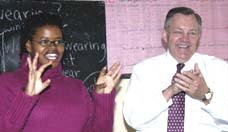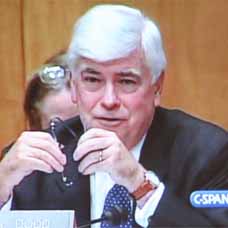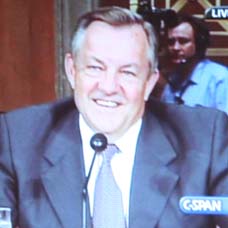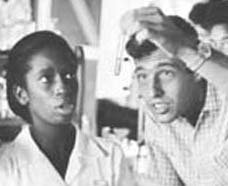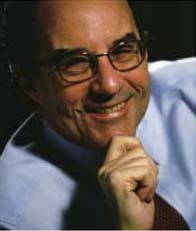
From an HR perspective, Poses and Costello had made significant strides. The company had top managers who prized HR, a management and planning system that incorporated HR strategy at the highest levels, and a talent-development system to guide assessment and development on a global level. But were the HR policies and practices really worth the time and effort? HR thought so, based on overall company performance. But Poses, who also had served as a financial analyst at AlliedSignal, wanted more. He wanted substantive proof, validation that his HR investments were paying off. Poses also wanted confirmation that employees appreciated what HR was doing for them. “He wanted to know how we know that someone in our businesses is experiencing or understanding the work we’re doing on their behalf,” Costello says.
RPCV Fred Poses, Chairman and CEO of American Standard believed in the business value of HR, and needed an HR partner who shared his strategic vision
Measuring the Value of HR
American Standard is taking big strides in showing the connection between good HR and a healthy bottom line.
By Robert J. Grossman
As head of HR at two different global companies—PepsiCo and Campbell Soup—Larry Costello seemed to have reached the pinnacle of the HR profession. Yet he wasn’t satisfied.
“I needed to find a place where I could prove the importance and power of people to the success of the business,” he says, “an environment where I could demonstrate the reality that you can differentiate people so they can influence stock price and performance.”
At about the same time, Fred Poses, formerly president and COO of AlliedSignal, became chairman and CEO of American Standard Cos. in Piscataway, N.J. The former Peace Corps volunteer believed in the business value of HR, and he needed an HR partner who shared his strategic vision.
Costello was just that person, and he joined American Standard as senior vice president for HR in July 2000. When he heard Poses discuss the key role HR needed to play at the company, Costello says, “it was music to my ears. He described the environment I wanted to create, and said he was prepared to put the resources and commit his own time to a journey that would get us there.”
It’s a journey still in progress. American Standard has not yet reached its final destination, but it has gone much further than most companies in quantifying the effects of HR and management practices on business performance. ›
Changes in the Wind
When Poses took the helm, American Standard was essentially a holding company that played a limited role in managing three very different lines of business:
* Bath and kitchen products (66 plants in 25 countries).
* Air-conditioning systems and services (29 plants in nine countries).
* Vehicle control systems (10 plants in seven countries).
While the company is best known for bath and kitchen products, 60 percent of its revenue comes from residential and commercial air-conditioning systems, sold under the American Standard and Trane brands, and braking and suspension systems for heavy trucks and buses, sold under the WABCO brand.
Bringing more centralized management of these disparate endeavors was a challenge, especially since American Standard is a vast organization: 61,200 employees in 28 countries. But it’s a challenge that Poses, with Costello’s help, attacked head-on by establishing new operationwide methods for managing key aspects of the business.
One of those new methods reflected a belief—shared by Poses and Costello—that to be competitive, a business must either develop or recruit the best possible talent. Thus, the duo quickly elevated strategic talent management to the top echelon of corporate planning and decision-making across all business units. As a result, American Standard now produces a strategic plan that looks out to the future, an annual operating plan that’s action-oriented and contains specific financial targets and metrics, and a human resource plan that includes talent assessments, forecasting and succession planning. All three plans are aligned and cascaded down throughout the organization so that every business unit and individual helps set goals that conform to the entire company’s mission and values.
What’s more, within HR, Costello worked to establish a state-of-the-art talent-development system that provides a one-stop, online location where employees and managers go to set goals, craft development plans, trade feedback, acquire skills and chart their progress.
Another key change was creating a matrix structure in which HR professionals in each business division report both to the corporate HR office and to the business’s top-line executive.
In Search of Proof
From an HR perspective, Poses and Costello had made significant strides. The company had top managers who prized HR, a management and planning system that incorporated HR strategy at the highest levels, and a talent-development system to guide assessment and development on a global level.
But were the HR policies and practices really worth the time and effort? HR thought so, based on overall company performance. But Poses, who also had served as a financial analyst at AlliedSignal, wanted more. He wanted substantive proof, validation that his HR investments were paying off.
Poses also wanted confirmation that employees appreciated what HR was doing for them. “He wanted to know how we know that someone in our businesses is experiencing or understanding the work we’re doing on their behalf,” Costello says.
In 2001, Costello’s search for a specialist who could help American Standard produce the proof it needed led him to Laurie Bassi, co-founder of McBassi and Co. in Boulder, Colo. Bassi held impressive credentials: economist, college professor, former vice president for research at the American Society for Training & Development, board chair of her own investment fund.
Bassi also had passion. She believes that for HR to be respected and accepted by top business leaders and the investment community, it must demonstrate the value of human capital in a language that such leaders understand.
In other words, numbers count.
“The business world is dominated by people who look at metrics, and the HR world needs to play in that space,” Bassi says. “If you can measure manufacturing efficiency with Six Sigma, why not use similar analytics to measure human capital performance?”
But measurement itself can take you only so far, Bassi says. “Getting on the scale does not make you lose weight, but it can give you incentive. Similarly, measurement can be a catalyst; it can point you in the right direction—help you zero in on the actions that can make the most difference.”
Weighing In—McBassi and the HCCS
To analyze the effectiveness of American Standard’s human capital management practices, McBassi prepared a customized 60-question employee survey designed to elicit responses that would reveal how effectively managers were performing core leadership and management functions.
Employees were asked to rate their manager’s performance on a scale of one to five in five broad categories: Leadership Practices, Employee Engagement, Knowledge Accessibility, Workforce Optimization and Learning Capacity. Bassi says that high scores in the Leadership Practices index “are consistently among the greatest predictors of [corporate financial] performance.” (For explanations of the five factors, see Table 1.)
The results of the survey were tabulated, broken into 23 subcategories and reported in McBassi’s Human Capital Capability Scorecard (HCCS). The scores are rated on a “Maturity Scale” that weighs the results for each manager against those in a proprietary “best practice” database. Maturity ratings run from one to five in each category, with five indicating optimum performance and one meaning little or none.
McBassi analyzes the survey results and links them statistically to business outcomes based on data provided by the company. Outcomes may include sales, turnover, retention or customer satisfaction, for example. American Standard chose to measure safety and financial performance of commercial sales offices.
The company’s managers were then rated by office or plant, by function and by region. To help determine where interventions could have the greatest impact, McBassi identified the human capital practices and processes that were the most critical drivers of business results.
The process allowed American Standard to develop a “decision science” for its human capital management, providing the company with analytical information on where to focus its HR budget and where to avoid investing additional time and money.
Proof Pours In
Initially, American Standard opted to test the HCCS in 2003 with 8,000 salaried employees in 130 reporting units in North America. Two of those units were in the Trane division—Commercial Systems Distribution and Residential Systems.
When the results came in, a shock wave ran through HR, says Craig Alexander, who works in American Standard’s corporate offices as director of organizational development. “In all categories across the board, we scored a ‘two,’ which was below average.” Those low scores translated into some rather disturbing, specific realizations. Alexander, a 15-year company veteran with experience as a business consultant and financial officer, says, “We were spending $20 million a year on learning and development, yet our people didn’t think we valued it!”
Along with the bad news came strategic news: The data showed direct relationships between managers’ overall maturity levels and their safety and revenue performance. For example, plants where managers scored in the top half on the overall maturity index had an average safety incident rate that was 14 percent better than those in the bottom half.
Alexander focused on raising the overall scores across the company, leaving it to executives of the individual businesses or units to decide how much deeper they wanted to drill.
John Conover, president of Trane’s Commercial Systems Distribution unit, was one executive who decided to zero in on specific areas where his managers should focus their efforts. His acceptance and use of the tool to guide management development was remarkable given that he was not an initial proponent of its use. At the outset, he resisted using the survey, and participated in the pilot only when Maureen MacInnis, the vice president of HR who reported to him, suggested it could improve his chances of reaching and exceeding his revenue goals.
When the results arrived, Conover was impressed. McBassi’s analysis showed that district sales offices that scored better in developing and managing talent—a factor that falls primarily under Leadership Practices—produced higher financial results. “We found that a manager of an office with a below-average HCCS overall score will produce $1 million less revenue than his counterpart with an above-average score,” he says.
So Conover asked Bassi to examine the data and recommend which areas his managers should focus on first for improvement. Bassi located the areas that correlated most closely with the company’s success, and recommended that Conover’s managers focus on boosting their Leadership Practices. This area, Bassi noted, is one that individual managers can most readily improve on their own; other factors require greater commitment and action from the company or division as a whole.
Conover looked at the data, took McBassi’s written suggestions, and used both to help guide the development of his managers. He asked each district manager and territory vice president—60 people in all—to develop plans for improving their 2003 Leadership Practices scores.
Since then, leaders of the five offices with the highest HCCS scores have gone on to bigger jobs; the five lowest scorers are no longer with the company. Staffing decisions were not made on HCCS results alone, but the scorecard is a significant factor in assessing overall performance.
Meanwhile, executives in the Residential Systems unit were finding patterns in their data as well. Says Tom Schlegel, the unit’s vice president of HR: “There were two major themes that stood out: People want more and clearer feedback on how they’re performing, and they want development plans that help them get better.”
So the division took action. “We made a commitment on improving these two things and built a system around it,” he says. “We told our employees, ‘We will give you good feedback relative to performance, and we’re committed to establishing a development plan for you that’s simple and meaningful, and then doing it.’ As a control, we developed a system to measure how well we were doing. Every one of our salaried employees got asked twice a year if their managers were following through.”
The result: Managers’ HCCS scores went up dramatically from 2003 to 2004.
eginning the Rollout
In 2005, American Standard extended the survey to 20,000 salaried employees in 300 reporting units. Some managers were assessed for the first time; for others, their 2003 results provided benchmark data.
As in 2003, on a companywide basis the McBassi business outcomes analysis proved prescient. Because of the priorities placed on improving areas identified on the scorecard, scores improved. Overall, the business units examined began to climb in maturity levels. (See Table 2.) As the scorecard index numbers rose in the aggregate, so did overall financial performance, as indicated by share value, says Alexander.
In addition, the correlations between individual manager performance and scorecard results remained powerful.
To be sure about the statistics, Alexander ran McBassi’s computations independently. “We took the sales offices and measured their financial performance against the overall HCCS ratings,” he says, “and found a 95 percent confidence level.”
Total Commitment
Poses had seen enough. He authorized a full rollout of the HCCS, with plans to repeat the process every 18 months. “Fred was skeptical at first; he’s seen a lot of tools. But he was convinced,” Costello says. As Poses says, “This is the clearest example I’ve ever seen of a diagnostic tool that can link directly to profitability.”
In the rollout, more than 60,000 people received surveys, and 75 percent responded; analysis and outcomes are pending.
When Costello presented the 2005 scorecard correlations and comparisons between 2003 and 2005 at his annual HR planning briefing with the board, the interest was palpable. “They were intrigued; they asked to see the data after each 18-month cycle so they could comprehend the influence of our people programs and how our leadership is reacting to them,” he says.
Now Costello is looking to the day when investment analysts, recognizing the critical impact of human capital on a company’s performance, will ask for metrics like the HCCS outcomes.
Some analysts, such as Edward Wheeler of the Buckingham Research Group, already seem prepared to listen. “So far, the metrics have not been available to me, and that’s probably because the company is still testing them,” he says. “But human capital is an important aspect of company performance, and I’d be interested in seeing the measures.”
(For information on sharing human capital management information with investors via corporate annual reports, see “Notable by Its Absence”.)
A New Perspective
Costello knew he had a winner with the HCCS when the business leaders bought in—when executives such as Conover and Dave Pannier, division president for Residential Systems, the business unit with the best HCCS overall in 2005, realized that the time they spent on talent development meant revenue in their columns.
Conover is the most vocal convert, extolling not only the tool but also the importance of HR to his organization. “I couldn’t spell HR when I took this job. Now I know better. It’s all about the people and the customer. And HR owns half that equation,” he says.
The fact that the scorecard has won companywide support is the ultimate sign of success for Costello. “The real difference is not about HR owning it; it’s about the entire business owning it,” he says. “Now even if Fred and I leave, these businesses believe in what we’re doing. They truly believe in the journey we’re on.”
Robert J. Grossman, a contributing editor of HR Magazine, is a lawyer and a professor of management studies at Marist College in Poughkeepsie, N.Y.
